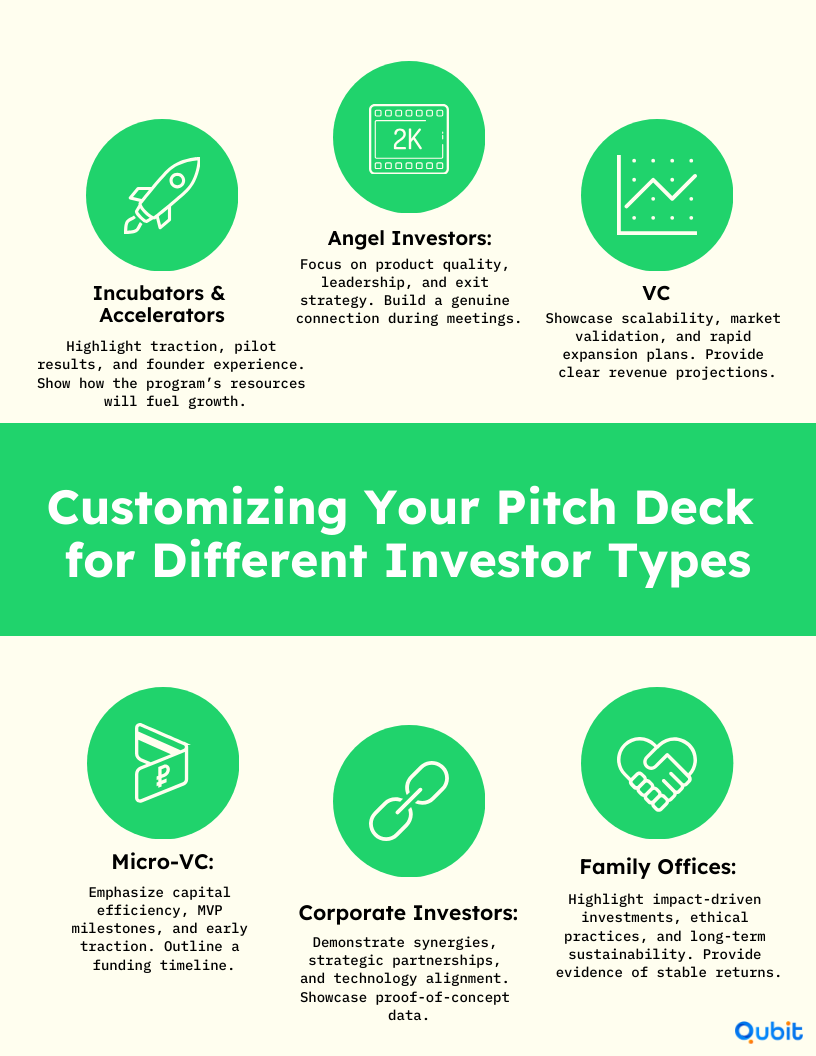Designing a compelling pitch deck for investors begins with truly understanding the distinct priorities of your audience. Investors tend to zero in on financial viability and market opportunity, while partners are more interested in strategic synergies that align with their goals.
Clients, on the other hand, look for clear value propositions, detailed product overviews, and credible success stories that build trust. Addressing these diverse expectations requires a customized communication strategy that ensures each group's interests are front and center.
So how do you customize your pitch deck for a specific investor? This article will show you how.
Tailoring your presentation to audience needs is an advanced pitch deck strategy that will greatly help you secure funding.
Customizing Your Content and Format
Understanding your audience is the foundation of crafting a pitch deck that resonates. Once you’ve pinpointed their priorities, tailoring your pitch deck for investors becomes a streamlined process. Investor-focused adjustments can make or break your pitch, helping you align content with their expectations.
Modern pitch deck templates are invaluable tools for aligning your design with investor expectations, ensuring a polished and cohesive presentation. A thoughtfully crafted startup pitch deck uses a logical slide order that reinforces your story from start to finish, making it easier for investors to grasp your objectives and the potential of your business. Each slide should flow naturally, reflecting the specific needs of your audience while weaving a compelling narrative.
Strategies for Different Investors
When targeting investors, your pitch deck needs to strike the right balance between hard data and a compelling narrative. You can try advanced strategies like incorporating emotional storytelling in a pitch deck which converts complex metrics into a persuasive argument, leaving a lasting impression.

There are other things you must consider when pitching to a specific investor.
Incubators and Accelerators
Entering an incubator or accelerator program can be transformative for early-stage startups seeking resources, mentorship, and credibility. When crafting your pitch, emphasize how their network and guidance will amplify your company’s trajectory. Include concise milestones to show your progress potential:
- Demonstrable traction or pilot results
- A clear timeline to validate market fit
- Supportive founder experience
Establish a personal connection by explaining why this specific program aligns with your sector and vision. Be prepared to highlight how you’ll use the provided resources—such as co-working spaces, workshops, or seed funding—to develop robust prototypes, refine your business model, and position your startup for subsequent funding rounds.
Angel Investors
A compelling and well-organized startup pitch deck is your key to capturing the interest of angel investors. Start your outreach by sharing your pitch deck along with a concise and tailored message. This initial communication should highlight your product quality, management capabilities, and a clearly defined exit strategy. Remember, the goal at this stage isn’t to overload the recipient with details but to spark enough curiosity for a face-to-face meeting where you'll elaborate further and address their questions.
Once invited to one-on-one meetings, prioritize building a genuine connection while demonstrating how your startup addresses specific market needs. These discussions are an opportunity to showcase the value of your pitch deck for investors, emphasizing structured metrics and ambitious yet achievable growth targets. Investors often evaluate the confidence and competence of the management team, alongside the product quality that sets the company up for long-term success.
For additional guidance, you may find it helpful to explore successful pitch examples. Studying these examples offers practical insights into investor preferences across various industries and helps refine your approach to creating an impressive startup pitch deck.
Venture Capital (VC)
When approaching venture capitalists, your pitch must spotlight scalability and high-growth potential. Introduce a compelling narrative that showcases your market validation and plans for rapid expansion.
Discuss potential returns through clear revenue projections and cost breakdowns, illustrating your path toward profitability. Highlight the depth of your management team, focusing on expertise that drives execution.
Investors often look for convincing evidence of product-market fit, such as enterprise partnerships or repeat customers. Demonstrate your openness to collaboration while retaining a confident stance on your strategic vision. Ultimately, show how VC support will accelerate momentum, fueling both your innovation and revenue milestones.
Micro-VC
Micro-VC firms typically invest in emerging startups before large VCs become involved, seeking strong early indicators of promise. When pitching them, emphasize lean operations, capital efficiency, and a rapidly testable product.
Share specific user feedback, early pilot data, or minimal viable product milestones that validate your approach. Present a timeframe for subsequent funding and highlight gaps these investors can help fill, such as market knowledge or strategic partnerships.
Keep financial projections grounded but optimistic, focusing on measurable growth metrics that reflect prudent spending. By demonstrating agility and foresight, you position your venture as both resilient and poised for steady expansion.
Corporate Investors
Corporate investors often look beyond financial returns, seeking synergies that bolster their core business or open new markets. In your pitch, illustrate how integration with their ecosystem—whether through shared technology, distribution channels, or strategic partnerships—can yield mutual value. Mention any existing collaborations, proofs of concept, or pilot programs that demonstrate compatibility. Be transparent about your roadmap, especially if proprietary research or patents appeal to their portfolio. Consider highlighting these aspects through bullet points:
- Shared growth opportunities
- Intellectual property or technology alignment
- Long-term market expansion strategy
By presenting a clear vision of how your startup enhances its competitiveness, you strengthen your investment proposition.
Family Office
Family offices often value stable, impact-driven investments that align with their legacy and social objectives. Tailor your pitch to showcase how your product or service meets these goals.
Emphasize ethical supply chains, sustainable business practices, or community engagement initiatives that elevate brand perception and reduce risk. Provide evidence of consistent returns through reliable customer retention or strategic partnerships, coupled with a clear timeline for incremental exits or dividend potential. Stress your management team’s integrity and long-term commitment to stakeholder relationships.
Family offices usually appreciate a balanced approach to growth and stewardship, so highlight steady scaling methods that mitigate risks while fostering resilience.
Getting Ready to Pitch Investors
Crafting an impactful startup pitch deck requires more than just a great idea. You’ll need a strong prototype, a financial roadmap with measurable goals—like achieving $10M in revenue within three years—and a clear depiction of how your product addresses market needs.
To stand out, your preparations should include a complete product overview, a well-articulated proof of concept, and detailed financial models. Tools like the Revenue Forecasting Template can be invaluable for creating realistic projections. Reviewing resources like the VC report can also sharpen your understanding of current funding trends.
When refining pitch deck templates, a clear and organized capitalization table is essential—it shows investors exactly how equity is distributed and helps them visualize your company’s structure.
Additionally, with firms like Andreessen Horowitz evaluating over 3,000 startup pitches annually but investing in only 15, the need for meticulous preparation cannot be overstated.
Incorporating social proof in your pitch deck through endorsements and testimonials can significantly elevate its credibility and showcase external validation of your concept.
Crafting a Concise Pitch Deck Presentation
A thoughtfully designed pitch deck serves as a compact snapshot of your startup, functioning much like a business card. By summarizing critical elements—such as your leadership, mission, product details, financials, and growth strategy—it aims to spark curiosity and pave the way for follow-up discussions about creating a pitch deck that truly shines.
The primary goal of a pitch deck isn’t to close deals immediately but to encourage potential investors to dive deeper by scheduling further conversations. It’s a tool for storytelling, revealing the essence of your startup compellingly. Below are the key components that can help elevate your pitch deck into a memorable and engaging presentation:
- Leadership and Mission: Shine a spotlight on your team’s expertise and the meaningful mission propelling your startup forward.
- Product Details: Deliver a crisp summary of your product, emphasizing how it works and the value it provides to users.
- Financial Overview: Share a concise snapshot of your current financial position alongside projected growth figures.
- Strategic Growth: Provide a roadmap of future goals and milestones, showcasing the market potential and scalability of your business.
Every slide matters. By keeping your content focused and avoiding unnecessary clutter, you maximize the impact of your presentation. In essence, a polished pitch deck is more than just a collection of slides; it’s a strategic gateway to essential meetings and deeper investor engagement. Let your pitch deck tell a story that investors can’t help but want to explore further.
Essential Components of an Investor Pitch Deck
A thoughtfully crafted pitch deck for investors serves as an impactful way to communicate your startup’s story while staying concise. Keeping your presentation between 10 and 20 slides ensures your message remains focused and compelling. This format highlights the essential elements that quickly grab an investor’s attention.
Tailoring your deck to specific investor audiences is equally significant, allowing you to adapt your pitch while leveraging proven pitch deck templates and an example pitch deck to structure your presentation effectively.
The key slides to include are:
- Cover: A striking visual paired with an engaging introduction to your brand.
- Value Proposition: A straightforward explanation of what makes your startup unique.
- Business Problem: A clear and concise outline of the market need you’re addressing.
- Market Opportunity: Insightful data showcasing the market size and its growth potential.
- Solution: A well-defined explanation of how your product or service solves the identified problem.
- Business Model: A snapshot of your revenue strategy that highlights profitability.
- Financials: Projections and key metrics that substantiate your vision and goals.
- Competitor Analysis: A balanced evaluation of existing alternatives in the market.
- Leadership: A brief introduction to your team, emphasizing their expertise and achievements.
- Fundraising Details: A transparent outline of your funding needs and how you plan to allocate the capital.
Conclusion
To wrap things up, the strategy presented throughout this discussion underscores the significance of a thoughtful blend of audience analysis, tailored content, and structured delivery. A narrative-driven pitch deck, enriched with data, transparent financial projections, and compelling storytelling, leaves a lasting impact. The inclusion of expert quotes and key statistics fortifies these strategies, building both credibility and trust.
These insights align with earlier findings, demonstrating how a well-designed pitch deck can set your presentation apart. By combining actionable insights with evidence-backed strategies, you establish a practical foundation to tackle common hurdles in pitching. The seamless integration of detailed data and clear financial projections creates a narrative that resonates deeply, making your pitch more compelling to potential investors.
We at Qubit Capital can help you build a compelling and memorable pitch deck that resonates with investors. Discover our pitch deck creation service to get started.
Key Takeaways
- Customizing your pitch deck is essential to address the unique needs of different investor types.
- Data-driven insights and clear storytelling are key to engaging investors effectively.
- A concise, tailored presentation of 10-20 slides enhances focus and retention.
- Utilizing specific tools, templates, and internal links further reinforces your message and credibility.
- Effective investor outreach and preparation are critical steps toward securing funding.
Frequently asked Questions
How should you tailor your pitch deck for different investors?
Crafting a pitch deck tailored to individual investors starts with understanding what matters most to them. Dive into their specific interests—whether it’s financial projections, market trends, or leadership expertise—and tweak your presentation accordingly. Highlight sections that align closely with their focus areas. Adding precise statistics and carefully curated data strengthens your argument, making your pitch not only informative but genuinely compelling.


 Back
Back



